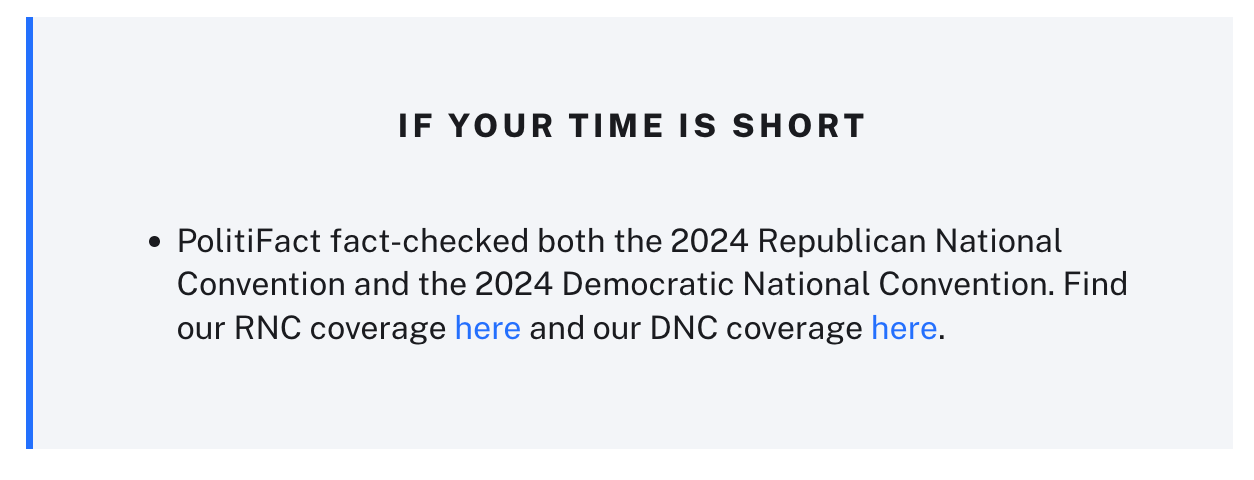
CNN’s Jake Tapper and Dana Bash took a lot of heat earlier this summer for their light moderation style — and lack of live fact-checking — during a presidential debate between Donald Trump and Joe Biden. The format was an intentional choice, agreed to by both campaigns. The approach wasn’t based on a lack of preparation, laziness or a […]
Does live coverage include fact-checking? Tell your audience
CNN’s Jake Tapper and Dana Bash took a lot of heat earlier this summer for their light moderation style — and lack of live fact-checking — during a presidential debate between Donald Trump and Joe Biden.
The format was an intentional choice, agreed to by both campaigns. The approach wasn’t based on a lack of preparation, laziness or a preference for either candidate, though we know those are conclusions a lot of people drew. But how would the public know that?
Whether to offer on-the-spot fact-checking is exactly the kind of decision journalists need to be pulling back the curtain on. How often do we spend hours in meetings discussing how to handle something then fail to explain our decision to our audience?
You’ve heard us say it for years: When we don’t explain ourselves, people fill in the blanks with their own assumptions, and those assumptions will most likely be negative. And it makes sense that people don’t *automatically* understand that fact-checking is its own kind of reporting, right? It doesn’t happen instantaneously, and doing it live is not always possible or the top priority. That doesn’t mean the journalists involved don’t care about facts.
So, let’s explain ourselves
Imagine if Tapper and Bash had taken 30 seconds in the setup time to explain what they would and would not be doing and why. The goal wouldn’t be widespread approval of the decision, necessarily. It would be demonstrating the thoughtfulness and integrity behind it.
PolitiFact’s Election 2024 FAQ page has a section about live fact-checking during debates. It addresses how they pull fact-checks from the archives in ways that might feel instant but are based on time-consuming previous reporting. They also shared a video with that information on Instagram, TikTok and Facebook.
Now, consider how this might apply to *your* journalism. Are you covering any debates this fall? How about candidate forums? If so, what will you do on deadline, and what will you circle back to later?
How about including an editor’s note with a deadline story that explains your approach? The language could also be useful on air, in a newsletter or in social posts or videos. Here are a couple of options.
Editor’s note: Our staff routinely fact-checks candidates for public office, and our approach is consistent across the political spectrum. Find those fact-checks on our election landing page (link). Stories like this one, written on deadline, are designed as summaries of a live event. They might include links to previous fact-checks but do not allow for new, in-depth fact-checking.
Editor’s note: This story, written on deadline Tuesday evening, summarizes key points made by the candidates at the forum. It links to some previous coverage but does not fact-check individual statements. Our staff is fact-checking their messaging throughout the campaign. You can find those fact-checks on our elections page (link).
When you DO fact-check, make sure to link to that coverage from all related stories. And make it clear that you fact-check consistently across party.
After covering the Democratic National Convention, the PolitiFact team went back into stories from both conventions and linked back and forth.

How have you explained your approach to fact-checking? Let us know here, on LinkedIn, X or email at info@trustingnews.org.

Executive Director Joy Mayer (she/her) founded Trusting News in 2016 after a 20-year career in newsrooms and teaching. She lives in Sarasota, Florida, and can be reached at joy@TrustingNews.org.



